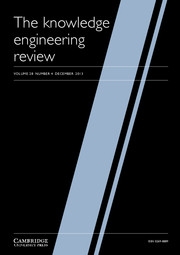Crossref Citations
This article has been cited by the following publications. This list is generated based on data provided by
Crossref.
Depaire, Benoît
Vanhoof, Koen
and
Wets, Geert
2008.
ARUBAS: An Association Rule Based Similarity Framework for Associative Classifiers.
p.
692.
Su, Zhitong
Song, Wei
Cao, Danyang
and
Li, Jinhong
2008.
Discovering Informative Association Rules for Associative Classification.
p.
1060.
Mavridou, Efthimia
Kehagias, Dionysios D.
Kalogirou, Konstantinos
and
Tzovaras, Dimitrios
2008.
An Agent-Oriented Data Mining Framework for Mass Customization in the Automotive Industry.
p.
575.
Kundu, Gourab
Islam, Md. Monirul
Munir, Sirajum
and
Bari, Md. Faizul
2008.
ACN: An Associative Classifier with Negative Rules.
p.
369.
Yanfang Ye
Qingshan Jiang
and
Weiwei Zhuang
2008.
Associative classification and post-processing techniques used for malware detection.
p.
276.
Ye, Yanfang
Li, Tao
Jiang, Qingshan
Han, Zhixue
and
Wan, Li
2009.
Intelligent file scoring system for malware detection from the gray list.
p.
1385.
Soni, Sunita
Pillai, Jyothi
and
Vyas, O.P.
2009.
An associative classifier using weighted association rule.
p.
1492.
Deng, Zhongjun
Zheng, Xuefeng
and
Song, Wei
2009.
Building Accurate Associative Classifier Based on Closed Itemsets and Certainty Factor.
p.
141.
Li, Xiao-Chen
Mao, Wen-Ji
Zeng, Daniel
Su, Peng
and
Wang, Fei-Yue
2009.
Performance Evaluation of Machine Learning Methods in Cultural Modeling.
Journal of Computer Science and Technology,
Vol. 24,
Issue. 6,
p.
1010.
Costa, Gianni
Guarascio, Massimo
Manco, Giuseppe
Ortale, Riccardo
and
Ritacco, Ettore
2009.
Data Warehousing and Knowledge Discovery.
Vol. 5691,
Issue. ,
p.
428.
Choo, Yun-Huoy
Bakar, Azuraliza Abu
and
Muda, Azah Kamilah
2009.
Capturing uncertainty in associative classification model.
p.
84.
Manikonda, L.
Mangalampalli, A.
and
Pudi, V.
2010.
UACI: Uncertain associative classifier for object class identification in images.
p.
1.
Jiang, Yuanchun
Shang, Jennifer
and
Liu, Yezheng
2010.
Maximizing customer satisfaction through an online recommendation system: A novel associative classification model.
Decision Support Systems,
Vol. 48,
Issue. 3,
p.
470.
Thabtah, Fadi
Mahmood, Qazafi
McCluskey, Lee
and
Abdel-Jaber, Hussein
2010.
A New Classification Based on Association Algorithm.
Journal of Information & Knowledge Management,
Vol. 09,
Issue. 01,
p.
55.
Mangalampalli, Ashish
Chaoji, Vineet
and
Sanyal, Subhajit
2010.
I-FAC: Efficient Fuzzy Associative Classifier for Object Classes in Images.
p.
4388.
Lu, Shing-Hwa
Chiang, Ding-An
Keh, Huan-Chao
and
Huang, Hui-Hua
2010.
Chinese text classification by the Naïve Bayes Classifier and the associative classifier with multiple confidence threshold values.
Knowledge-Based Systems,
Vol. 23,
Issue. 6,
p.
598.
Yanfang Ye
Tao Li
Qingshan Jiang
and
Youyu Wang
2010.
CIMDS: Adapting Postprocessing Techniques of Associative Classification for Malware Detection.
IEEE Transactions on Systems, Man, and Cybernetics, Part C (Applications and Reviews),
Vol. 40,
Issue. 3,
p.
298.
Bernardini, Andrea
and
Conati, Cristina
2010.
Intelligent Tutoring Systems.
Vol. 6094,
Issue. ,
p.
125.
Chang Chien, Ya-Wen
and
Chen, Yen-Liang
2010.
Mining associative classification rules with stock trading data – A GA-based method.
Knowledge-Based Systems,
Vol. 23,
Issue. 6,
p.
605.
Bakar, Azuraliza Abu
Othman, Zalinda
Yusoff, Mohd Saiful Nizam Md
and
Ismail, Ruhaizan
2010.
Development of knowledge model for insurance product decision using the associative classification approach.
p.
1481.

